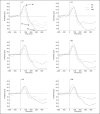Auditory perception exhibits sexual dimorphism and left telencephalic dominance in Xenopus laevis
- PMID: 30509903
- PMCID: PMC6310876
- DOI: 10.1242/bio.035956
Auditory perception exhibits sexual dimorphism and left telencephalic dominance in Xenopus laevis
Abstract
Sex differences in both vocalization and auditory processing have been commonly found in vocal animals, although the underlying neural mechanisms associated with sexual dimorphism of auditory processing are not well understood. In this study we investigated whether auditory perception exhibits sexual dimorphism in Xenopus laevis To do this we measured event-related potentials (ERPs) evoked by white noise (WN) and conspecific calls in the telencephalon, diencephalon and mesencephalon respectively. Results showed that (1) the N1 amplitudes evoked in the right telencephalon and right diencephalon of males by WN are significantly different from those evoked in females; (2) in males the N1 amplitudes evoked by conspecific calls are significantly different from those evoked by WN; (3) in females the N1 amplitude for the left mesencephalon was significantly lower than for other brain areas, while the P2 and P3 amplitudes for the right mesencephalon were the smallest; in contrast these amplitudes for the left mesencephalon were the smallest in males. These results suggest auditory perception is sexually dimorphic. Moreover, the amplitude of each ERP component (N1, P2 and P3) for the left telencephalon was the largest in females and/or males, suggesting that left telencephalic dominance exists for auditory perception in Xenopus.
Keywords: Auditory perception; Event-related potentials (ERPs); Sexual dimorphism; Telencephalon; Xenopus laevis.
© 2018. Published by The Company of Biologists Ltd.
Conflict of interest statement
Competing interestsThe authors declare no competing or financial interests.
Figures






Similar articles
-
Sound Classification and Call Discrimination Are Decoded in Order as Revealed by Event-Related Potential Components in Frogs.Brain Behav Evol. 2015;86(3-4):232-45. doi: 10.1159/000441215. Epub 2015 Nov 28. Brain Behav Evol. 2015. PMID: 26613526
-
Hierarchical auditory perception for species discrimination and individual recognition in the music frog.Curr Zool. 2021 Oct 13;68(5):581-591. doi: 10.1093/cz/zoab085. eCollection 2022 Oct. Curr Zool. 2021. PMID: 36324532 Free PMC article.
-
Auditory sensitivity exhibits sexual dimorphism and seasonal plasticity in music frogs.J Comp Physiol A Neuroethol Sens Neural Behav Physiol. 2018 Dec;204(12):1029-1044. doi: 10.1007/s00359-018-1301-1. Epub 2018 Oct 30. J Comp Physiol A Neuroethol Sens Neural Behav Physiol. 2018. PMID: 30377768
-
Auditory event-related potentials in the study of developmental language-related disorders.Audiol Neurootol. 1997 Sep-Oct;2(5):308-40. doi: 10.1159/000259254. Audiol Neurootol. 1997. PMID: 9390838 Review.
-
Event-related potentials as a measure of sleep disturbance: a tutorial review.Noise Health. 2010 Apr-Jun;12(47):137-53. doi: 10.4103/1463-1741.63216. Noise Health. 2010. PMID: 20472959 Review.
Cited by
-
Reprogramming the topology of the nociceptive circuit in C. elegans reshapes sexual behavior.Curr Biol. 2022 Oct 24;32(20):4372-4385.e7. doi: 10.1016/j.cub.2022.08.038. Epub 2022 Sep 7. Curr Biol. 2022. PMID: 36075218 Free PMC article.
-
Neural activities in music frogs reveal call variations and phylogenetic relationships within the genus Nidirana.Commun Biol. 2022 Jun 6;5(1):550. doi: 10.1038/s42003-022-03504-8. Commun Biol. 2022. PMID: 35668095 Free PMC article.
-
Preference of spectral features in auditory processing for advertisement calls in the music frogs.Front Zool. 2019 May 10;16:13. doi: 10.1186/s12983-019-0314-0. eCollection 2019. Front Zool. 2019. PMID: 31168310 Free PMC article.
-
Sexually dimorphic architecture and function of a mechanosensory circuit in C. elegans.Nat Commun. 2022 Nov 11;13(1):6825. doi: 10.1038/s41467-022-34661-3. Nat Commun. 2022. PMID: 36369281 Free PMC article.
-
Sex differences in vocalization are reflected by event-related potential components in the music frog.Anim Cogn. 2020 May;23(3):477-490. doi: 10.1007/s10071-020-01350-x. Epub 2020 Feb 3. Anim Cogn. 2020. PMID: 32016618
References
-
- Anderer P., Pascual-Marqui R. D., Semlitsch H. V. and Saletu B. (1998). Differential effects of normal aging on sources of standard N1, target N1 and target P300 auditory event-related brain potentials revealed by low resolution electromagnetic tomography (LORETA). Electroencephalogr. Clin. Neurophysiol. 108, 160-174. 10.1016/S0168-5597(97)00080-4 - DOI - PubMed
LinkOut - more resources
Full Text Sources
Molecular Biology Databases

